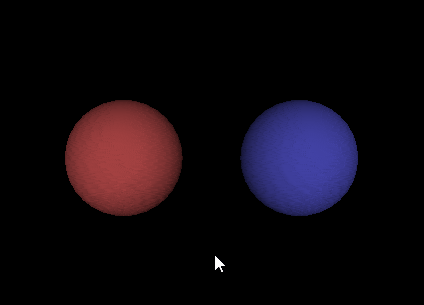如果您想在窗口中选择一个点,则必须将窗口坐标转换为世界坐标或对象坐标。
要将窗口坐标映射到对象坐标,可以使用gluUnProject。
gluUnProject的参数类型为GLdouble。
创建一个GLdouble类型的投影矩阵和视图矩阵数组以及一个GLint类型的视口矩形数组:
self.mv_mat = (GLdouble * 16)()
self.p_mat = (GLdouble * 16)()
self.v_rect = (GLint * 4)()
获取当前投影矩阵、模型视图矩阵和视口矩形:
glGetDoublev(GL_MODELVIEW_MATRIX, self.mv_mat)
glGetDoublev(GL_PROJECTION_MATRIX, self.p_mat)
glGetIntegerv(GL_VIEWPORT, self.v_rect)
在视口上绘制了一个三维场景的二维(透视)投影。场景从一个点,即相机位置观察。要找到窗口中“选定”的对象,必须找到对象所在的视线。一条射线由两个点定义。找到靠近相机的点和深度场景中远离的点,它们位于“选定”窗口位置上以定义射线。被选中的对象是最靠近相机的对象。在标准化设备空间中,所有具有相同x和y坐标的点都在同一条射线上,从相机位置看来。
窗口空间中点的第一和第二坐标是像素的x和y坐标,第三个坐标是范围[0,1]内的深度。
因此,通过从相机附近到远处深度的坐标
(x,y)定义的射线由两个点
p0和
p1定义。其中:
p0 = (x, y, 0)
p1 = (x, y, 1)
这两个点必须通过
gluUnProject转换为世界空间:
ray_near = [GLdouble() for _ in range(3)]
ray_far = [GLdouble() for _ in range(3)]
gluUnProject(x, y, 0, mv_mat, p_mat, v_rect, *ray_near)
gluUnProject(x, y, 1, mv_mat, p_mat, v_rect, *ray_far)
如果从球的中心点到射线上最近点的距离小于或等于球的半径,则射线与球相交。
计算射线的归一化方向:
p0 = [v.value for v in ray_near]
p1 = [v.value for v in ray_far]
r_dir = np.subtract(p0, p1)
r_dir = r_dir / np.linalg.norm(r_dir)
计算射线到球的中心点的最近点:
p0_cpt = np.subtract(p0, cpt)
near_pt = np.subtract(p0, r_dir * np.dot(p0_cpt, r_dir))
计算射线上的点到中心点的距离:
dist = np.linalg.norm(np.subtract(near_pt, cpt))
如果距离小于或等于球体的半径,则光线会击中球体:
isIntersecting = dist <= radius
查看简短的PyGlet示例:

from pyglet.gl import *
from pyglet.window import key
import numpy as np
class Window(pyglet.window.Window):
def __init__(self, *args, **kwargs):
super().__init__(*args, **kwargs)
self.sphere = gluNewQuadric()
self.vp_valid = False
self.mouse_pos = (0, 0)
self.mv_mat = (GLdouble * 16)()
self.p_mat = (GLdouble * 16)()
self.v_rect = (GLint * 4)()
def on_resize(self, width, height):
self.vp_valid = False
def isectSphere(self, p0, p1, cpt, radius):
r_dir = np.subtract(p0, p1)
r_dir = r_dir / np.linalg.norm(r_dir)
p0_cpt = np.subtract(p0, cpt)
near_pt = np.subtract(p0, r_dir * np.dot(p0_cpt, r_dir))
dist = np.linalg.norm(np.subtract(near_pt, cpt))
return dist <= radius
def on_draw(self):
if not self.vp_valid:
self.vp_valid = True
glViewport(0, 0, self.width, self.height)
glMatrixMode(GL_PROJECTION)
glLoadIdentity()
gluPerspective(45, self.width/self.height, 0.1, 50.0)
glMatrixMode(GL_MODELVIEW)
glLoadIdentity()
gluLookAt(0, -8, 0, 0, 0, 0, 0, 0, 1)
glGetDoublev(GL_MODELVIEW_MATRIX, self.mv_mat)
glGetDoublev(GL_PROJECTION_MATRIX, self.p_mat)
glGetIntegerv(GL_VIEWPORT, self.v_rect)
temp_val = [GLdouble() for _ in range(3)]
gluUnProject(*self.mouse_pos, 0, self.mv_mat, self.p_mat, self.v_rect, *temp_val)
self.mouse_near = [v.value for v in temp_val]
gluUnProject(*self.mouse_pos, 1, self.mv_mat, self.p_mat, self.v_rect, *temp_val)
self.mouse_far = [v.value for v in temp_val]
isect_a = self.isectSphere(self.mouse_near, self.mouse_far, [-1.5, 0, 0], 1)
isect_b = self.isectSphere(self.mouse_near, self.mouse_far, [1.5, 0, 0], 1)
glEnable(GL_DEPTH_TEST)
glEnable(GL_LIGHTING)
glShadeModel(GL_SMOOTH)
glEnable(GL_COLOR_MATERIAL)
glColorMaterial(GL_FRONT_AND_BACK, GL_AMBIENT_AND_DIFFUSE)
glEnable(GL_LIGHT0)
glLightfv(GL_LIGHT0, GL_AMBIENT, (GLfloat *4)(0.1, 0.1, 0.1, 1))
glLightfv(GL_LIGHT0, GL_DIFFUSE, (GLfloat *4)(1.0, 1.0, 1.0, 1))
glLightfv(GL_LIGHT0, GL_POSITION, (GLfloat *4)(0, -1, 0, 0))
glClear(GL_COLOR_BUFFER_BIT|GL_DEPTH_BUFFER_BIT)
glPushMatrix()
glTranslatef(-1.5, 0, 0)
if isect_a:
glColor4f(1.0, 0.5, 0.5, 1)
else:
glColor4f(0.5, 0.2, 0.2, 1)
gluSphere(self.sphere, 1.0, 32, 16)
glTranslatef(3, 0, 0)
if isect_b:
glColor4f(0.5, 0.5, 1.0, 1)
else:
glColor4f(0.2, 0.2, 0.5, 1)
gluSphere(self.sphere, 1.0, 32, 16)
glPopMatrix()
def on_mouse_motion(self,x,y,dx,dy):
self.mouse_pos = (x, y)
if __name__ == "__main__":
window = Window(width=800, height=600, resizable=True)
pyglet.app.run()
